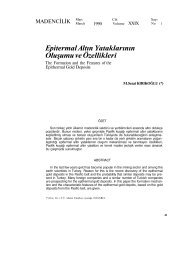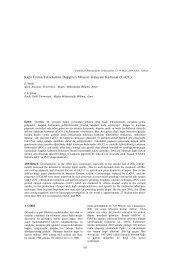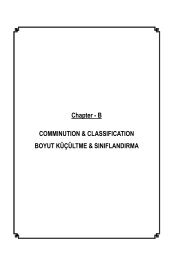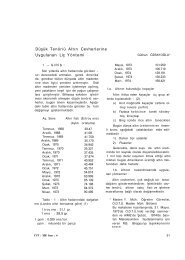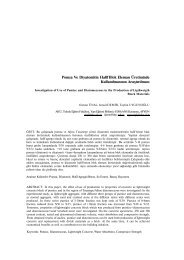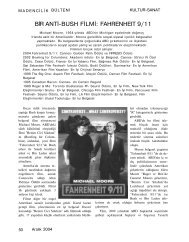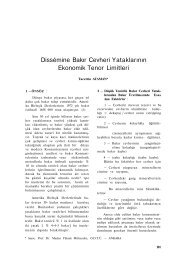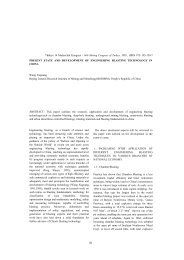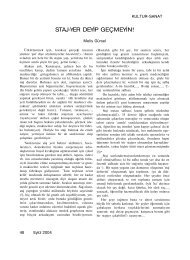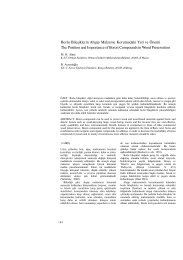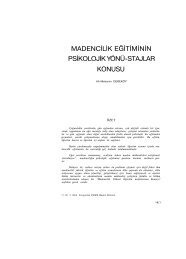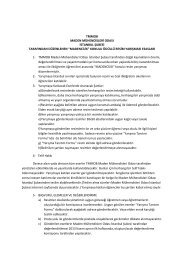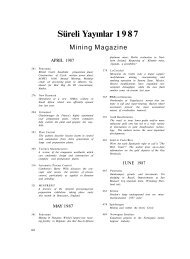A OPEN PIT MINING AÇIK OCAK MADENCİLİĞİ
A OPEN PIT MINING AÇIK OCAK MADENCİLİĞİ
A OPEN PIT MINING AÇIK OCAK MADENCİLİĞİ
Create successful ePaper yourself
Turn your PDF publications into a flip-book with our unique Google optimized e-Paper software.
23 rd <br />
4 DISCUSSION<br />
The results of measurements and comparison<br />
with the air quality limit values for average<br />
annual value, but also for the high value<br />
notes that all of the measured values of<br />
emissions of harmful pollutants are below<br />
the prescribed limits. The reason for this is<br />
the dynamic of removing overburden from<br />
the mine waste and tailings from mining. The<br />
frequency of vehicles on the roads is at a<br />
frequency of 1 dig vehicle is moving toward<br />
the landfill every 13 minutes, until it returns<br />
with another vehicle disposal on land.<br />
Crossing takes place in the middle the route,<br />
or the part of the route that passes through<br />
the village . Such traffic frequency is<br />
not characterized by driving transport<br />
vehicles in the row, and the emissions of<br />
exhaust gases, regardless of the amount and<br />
concentration, are not high enough to<br />
significantly influence the general change in<br />
the air quality in the investigated area.<br />
However, no matter the measured values of<br />
gaseous pollutants are below the limit, it is<br />
indicative that the laboratory analysis<br />
showed the appearance of harmful pollutants<br />
that are not found in the natural setting of the<br />
village, but that they are the result of the<br />
effects of mining operations located in the<br />
village environment . Traces of<br />
extremely harmful pollutants, formaldehyde<br />
and acrolein in the atmosphere of the village,<br />
which is emitted from the exhaust gases of<br />
diesel pick-up trucks, warn that some<br />
measures to reduce emissions of these<br />
pollutants have to be made.<br />
Measurements of emissions and dust settling<br />
airborne dust is determined as follows:<br />
- From these measurement points at the<br />
measuring point 7, which is located at 20 m<br />
from the route of transport, maximum<br />
concentrations were determined for the<br />
average monthly value of precipitated<br />
powder (4610.83 mg/m 2 day). Concentration<br />
of precipitated powder-dust sediment, the<br />
other measuring points are also above the<br />
normative value of 200 mg/m 2 day, ie from<br />
350 mg/m 2 day.<br />
- Imission deposited dust decreased<br />
significantly with increasing distance from<br />
the pathway. For the measurement of 100 m<br />
away from the route of transport emissions<br />
of dust deposited in the winter go below<br />
normative values. These results indicate that<br />
the effect of truck transport decreases with<br />
distance from the pathway.<br />
- At tests were being conducted during<br />
two periods, winter and spring, it can be seen<br />
that the spring feature has higher emissions,<br />
dust settling on the measuring cells<br />
immediately around the route, which is<br />
logical, because the emitted dust is mostly<br />
deposited directly at the source of dust. The<br />
winter has generally lower concentrations of<br />
dust settling on the section of the route<br />
compared to the spring, although the values<br />
are still above the concentration limits.<br />
- The maximum value of particulate<br />
matter less than 10 micrometers (LC-10) was<br />
measured in terms of: Dry, truck freight<br />
works at the measuring point 7, and 20 m<br />
from the transport route.<br />
- The exceeding of the airborne dust<br />
concentration was measured in all cases<br />
except when it's wet, then transport does not<br />
work.<br />
- Total suspended particles present<br />
floating dust sizes up to 40 micrometers.<br />
According to the measurements of the largest<br />
ULC dust emissions were measured in the<br />
dry period when there is truck transport.<br />
- Decline the airborne dust with<br />
increasing distance of transport routes is not<br />
as enhanced as in the sedymentary dust.<br />
Emissions, dust suspended above the<br />
allowable values for measurement points that<br />
are further away from transport routes.<br />
193



